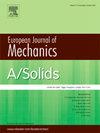Through-thickness modelling of metal rolling using multiple-scales asymptotics
IF 4.4
2区 工程技术
Q1 MECHANICS
引用次数: 0
Abstract
A new semi-analytic model of the metal rolling process is introduced, which, for the first time, is able to predict the through-thickness stress and strain oscillations present in long thin roll-gaps. The model is based on multiple-scales asymptotics, assuming a long thin roll-gap and a comparably small Coulomb friction coefficient. The leading-order solution varies only on a long lengthscale corresponding to the roll-gap length and matches with slab models. The next-order correction varies on both this long lengthscale and a short lengthscale associated with the workpiece thickness, and reveals rapid stress and strain oscillation both in the rolling direction and through the thickness. For this initial derivation, the model assumes a rigid perfectly-plastic material behaviour. Despite these strong assumptions, this model compares well with finite element simulations that employ more realistic material behaviour (including elasticity and strain hardening). These assumptions facilitate the simplest possible model to provide a foundational understanding of the complex through-thickness behaviour observed in the finite element simulations, while requiring an order of only seconds to compute. This model can form the foundation of further improved models with more complicated mechanics in the future. Matlab code for evaluating the model is provided in the supplementary material.
基于多尺度渐近的金属轧制全厚建模
介绍了一种新的金属轧制过程半解析模型,该模型首次能够预测长薄辊隙中存在的贯穿厚度的应力和应变振荡。该模型是基于多尺度渐近,假设一个长而薄的滚隙和一个比较小的库仑摩擦系数。首阶解仅在与辊缝长度相对应的长尺度上变化,并与板坯模型相匹配。下一阶修正在与工件厚度相关的长长度尺度和短长度尺度上都是不同的,并且在轧制方向和厚度上都显示出快速的应力和应变振荡。对于这个初始推导,模型假定为刚性的完全塑性材料行为。尽管有这些强有力的假设,但该模型与采用更真实的材料行为(包括弹性和应变硬化)的有限元模拟相比要好得多。这些假设有助于最简单的模型,以提供对有限元模拟中观察到的复杂穿透厚度行为的基本理解,同时只需要几秒钟的计算。该模型可以为未来更复杂力学的进一步改进模型奠定基础。在补充资料中提供了评估模型的Matlab代码。
本文章由计算机程序翻译,如有差异,请以英文原文为准。
求助全文
约1分钟内获得全文
求助全文
来源期刊
CiteScore
7.00
自引率
7.30%
发文量
275
审稿时长
48 days
期刊介绍:
The European Journal of Mechanics endash; A/Solids continues to publish articles in English in all areas of Solid Mechanics from the physical and mathematical basis to materials engineering, technological applications and methods of modern computational mechanics, both pure and applied research.

 求助内容:
求助内容: 应助结果提醒方式:
应助结果提醒方式:


